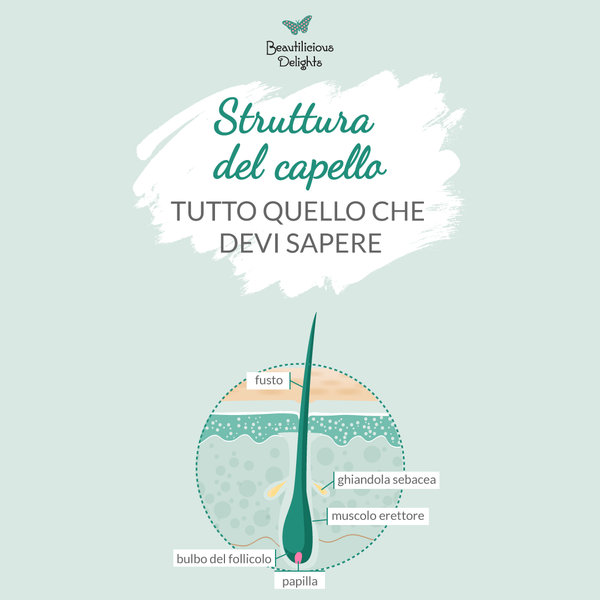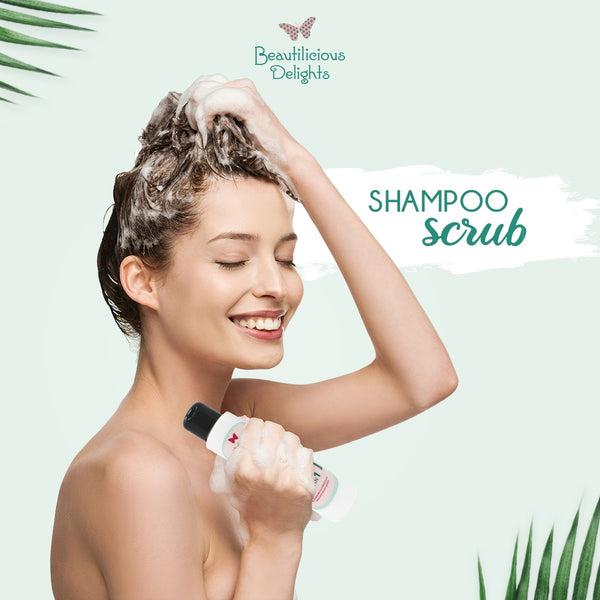Many of us find ourselves fighting it and complaining of having to wash our hair every 2 days and in the worst case even every day. But what is seborrhea and how can we fight it naturally?
Seborrhea: what is it?
The term seborrhea indicates the hypersecretion of the sebaceous glands and this process which affects the scalp can lead to a very common situation for everyone: greasy or greasy hair.
Seborrhea is a real pathology of the scalp due to an excessive production of sebum, caused by the hyperactivity of the sebaceous glands.
Sebogenesis - how sebum is born
The sebaceous glands pour their contents into the pilosebaceous duct, which is thus distributed on the scalp.

Sebum is made up of
- triglycerides,
- esters derived from long-chain fatty acids and fatty alcohols,
- and Squalene (substance characteristic of human sebum and very rare in the animal kingdom).
In the hair duct there are microorganisms ( Pityrosporum ovale, Staphylococcus epiermidis, Propionibacterium acnes ) which carry out an intense enzymatic action against Triglycerides, with the release of fatty acids.
The sebum, modified by the bacterial flora, then reaches the skin surface where skin secretions are also added ( free cholesterol and its esters, glycerides ).
The role of sebum
A hydrolipidic film is present on the skin and therefore also on the scalp; 95% of the lipid content is mainly made up of the sebum produced by the sebaceous glands.
In case of PHYSIOLOGICAL SEBORRHEA it is sebum that has the role of
- protect the skin from dehydration and external agents (sun, cold, dust, bacteria, etc.) thanks to its antibacterial properties.
- moisten, lubricate and waterproof the stem already during the growth phase inside the follicles
The excess of sebum leads to an alteration of the hydro-lipid balance of the skin. In this case we can talk about PATHOLOGICAL SEBORREA: the skin can appear dry and wrinkled when the sebum fails to reach the surface, remaining blocked inside the follicles.
This phenomenon is difficult to quantify and varies from individual to individual.
The sebaceous glands are well functioning at birth and for a few months due to the hormonal stimulus received from the mother.
Subsequently and until puberty these glands remain practically inactive and the only lipids (fats) present on the skin are those that come from the epidermis.
With puberty, both in males and females, hormonal activity begins and in particular the production of testosterone. (Testosterone is an androgen hormone produced in males by the testicles and in females by the adrenal glands).
At the beginning of puberty the production of sebum is identical in both sexes but, starting from the age of 16-18 it is significantly more abundant in males, and precisely in males this production continues until old age while, in females, it tends to regress in concomitance with menopause, a biological period in which there is a decrease in hormones.
The sebum produced by the sebaceous glands has a precise role, not only in contributing to the formation of the hydrolipidic film on the skin, as we have seen previously, but also has the function of lubricating the hair as it grows upwards.
When the quantity of sebum produced is excessive due to various external environmental agents (products that are too aggressive on the skin or infections due to poor hygiene) we speak of OCCASIONAL SEBORRHEA.
What causes excess sebum?
The causes can be various:
- The use of too aggressive cosmetic products with a too degreasing action that compromise the acid-hydro-lipid balance of the skin
- Too vigorous and prolonged massages on the skin can be negative by increasing hypersecretion and therefore seborrhea.
- Its presence on the skin of pathogenic microorganisms (infections) usually leads to sebaceous hypersecretion.
- The use of heat increases excessive sweating and fluidifies the sebum, making the hair greasy.
The consequences of seborrhea
We certainly know that excess sebum often results in a weakening of the hair follicle even if it is not able to atrophy it directly.
95% of male alopecias can be linked to an exaggerated sebaceous secretion (also known under the name of seborrheic alopecia).
An excessive secretion of sebum consequently produces an oiliness of the scalp and hair and is accompanied by an accumulation of sebum in the hair follicle.
This accumulation, connected to the prolonged contact between sebum and hair, reduces the growth rate of new hair.
Greasy hair also causes unpleasant blemishes:
-
they pile up,
-
are weighed down by too much sebum,
-
they don't keep their hairdo,
-
they go limp.
Scalp and forehead appear shiny, moist and sometimes there may be a bad smell due to the oxidation of lipids which causes rancidity.
Seborrhea: let's dispel a myth
Several studies on excessive sebum production have now shown that the sebaceous gland does not respond to external stimuli , so sebum production cannot be stimulated by treatments such as shampoo.
This goes to dispel the phenomenon according to which washing the hair often would create a stimulation of the sebaceous glands and the greater production of sebum, the famous "rebound" effect.
The production of sebum by the sebaceous glands is exclusively under hormonal control (testosterone). In particular, it should be remembered that the sebaceous gland does not have its own innervation capable of responding to stimuli.
The maturation of the sebocytes, the vesicles that produce sebum inside the sebaceous gland have a maturation time of about a week, therefore washing the hair removes the sebum which has already been produced and which surfaces on the surface of the skin, but does not affect the sebogenesis.
So frequent washing does not affect the secretion of the sebaceous gland and does not lead to an increase in sebum production. Just be careful to choose a suitable product for an already tested skin to avoid damaging the hair structure.
What to do in case of excess sebum?
In a condition of seborrhea, scalp and oily hair, washing plays a fundamental role in removing the excess of sebum which blocks the follicular ostium, the small exit hole of the hair on the scalp.
Hair, as we have seen above, can also be washed every day. Just use the right products. Indeed, in some cases it is recommended to do so to avoid bacterial proliferation which can only aggravate the condition of the skin.
But not only that, for this problem there are functional substances both of synthesis and of vegetable origin which have the important role of normalizing the skin flora which decomposes the sebum, transforming it into irritating substances for the skin.
So let's see together some of the ingredients used for this purpose.
Cosmetic treatment of seborrhea
The cosmetic treatment of seborrhea is linked to the attempt to control or reduce a state of moderate seborrhea, leaving the acute phase to dermatological care and performing an adjuvant action in the latter case.
Antiseborrheic drugs must possess the following characteristics:
- Eliminate excess sebum without carrying out an excessive cleansing action; therefore, shampoos with a high cleaning power or with a high ability to remove grease should be excluded.
- Eliminate the itch
- Possess bacteriostatic/cide and fungistatic/cide properties
Antiseborrheic substances, let's see some of them.
- Sulfur, for years sulfur and its derivatives have been considered the specific remedy for seborrhea, thanks to its fungicidal, antipruritic and keratolytic action.
- Selenium disulphide, used in cases of greasy dandruff and seborrheic dermatitis.
- Sulfur-based amino acids are used in the treatment of dandruff seborrhea.
Among the plant extracts, used in cosmetic products in order to control the seborrheic state, we mention:
- Burdock (Actium lappa) with a recognized antibacterial activity which makes it effective in the treatment of seborrhea.
- Birch (Betulla alba) used as an antiseborrheic and disinfectant of the scalp thanks to the action of tannins and saponins.
- Fennel (Foeniculum vulgare) has a slight antiseptic action which is associated with a degreasing action, in association with other extracts it is useful in reducing excess sebum.
- Lemon (Citrus limonum) Lemon essential oil has a bactericidal action and is used in cosmetic preparations aimed at reducing dandruff and sebeorrhoea.
- Mint (Peppermint) The essential oil is a powerful bactericide and has a marked calming activity against the annoying itching that often accompanies seborrhea.
- Rosemary (Rosmarinus officinalis) Also in this case the essential oil has a fat-reducing and antiseptic action which makes it useful in trichological preparations.
Text edited by Francesca Esposito Amendola - Doctor Trichologist
I conclude by reminding you that a healthy scalp is the first step to having healthy and beautiful hair. So rather than focusing on styling for shiny hair, start with scalp care first.
© Beautiful Delights
In the online shop you will find everything you need (including herbal dyes) to take care of your skin and hair in a conscious way. Click HERE to visit it!
************************************************** ************************************
Keep in touch with us:
Follow us on SOCIAL by clicking on the icons below to stay up to date on the latest news:
Rozalia & the Beautilicious Delights Team.






